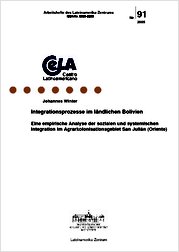Integrationsprozesse im ländlichen Bolivien
Eine empirische Analyse der sozialen und systemischen Integration im Agrarkolonisationsgebiet San Julián (Oriente)
| dc.contributor.author | Winter, Johannes | |
| dc.date.accessioned | 2008-07-18T09:21:27Z | |
| dc.date.accessioned | 2010-10-07T11:27:18Z | |
| dc.date.accessioned | 2010-11-22T14:35:17Z | |
| dc.date.available | 2008-07-18T09:21:27Z | |
| dc.date.available | 2010-10-07T11:27:18Z | |
| dc.date.available | 2010-11-22T14:35:17Z | |
| dc.date.issued | 2005 | |
| dc.identifier.citation | Arbeitshefte des Lateinamerika-Zentrums; 1991 | |
| dc.identifier.uri | http://hdl.handle.net/11858/00-1735-0000-0001-3342-B | |
| dc.description.abstract | Das östliche Tiefland von Bolivien, der so genannte Oriente, wird seit nunmehr einem halben Jahrhundert von umfangreichen Zuwanderungen aus den benachbarten Provinzen und dem Hochland heimgesucht. Dabei ist die Binnenmigration ein demographisches Phänomen, das den Oriente auf unterschiedliche Weise in seiner Regionalentwicklung beeinträchtigt. Einerseits kommt es zu einer tiefgründigen Modifikation der Landschaft durch Nutzung und Ausbeutung der natürlichen Ressourcen. Anderseits führen die Wanderungsbewegungen zu einer sukzessiven Transformation der Aufnahmegesellschaft. Intensität und Ausmaß der Gesellschaftsveränderungen hängen vom Grad der Integration der beteiligten Akteure ab. Es ist davon auszugehen, dass sowohl das gesellschaftliche als auch das ökologische Gleichgewicht davon abhängen, inwieweit eine Eingliederung der zugewanderten Individuen und Gruppen in das soziale System (soziale Integration) gelingt, – und inwieweit die verschiedenen Teilbereiche der Gesellschaft (politisches, ökonomisches, soziales und edukatives System) im Austausch miteinander stehen bzw. harmonieren. Die empirische Feldforschung im Agrarkolonisationsgebiet San Julián (Departamento de Santa Cruz) bezog sich auf den Zusammenhang zwischen der Integration von Zuwanderern und den Auswirkungen auf die regionale Kulturlandschaft. | |
| dc.description.abstract | Internal rural migration is a demographic phenomenon which affects the eastern Bolivian lowlands mainly in two different ways. On the one hand the migrations provoke a profound modification of the landscape by exploitation and potential degradation of the natural resources. On the other hand massive inflows of migrants cause the transformation of the local society. Intensity and dimension of those modifications depend on the level of integration of the individuals and groups which are involved. Consequently, the inclusion of the actors into the social system (social integration) as well as the relationship between the parts of the society (systemic integration) determine the societal as well as the ecological equilibrium. An empirical analysis of the integration process of migrants from the Andean highlands was realised in the colonisation area of San Julián, Dpt. of Santa Cruz, Bolivia. One main aspect of the investigation focused on the rural poverty and different standards of living of migrant and local households. Empirical data were collected through semi-structured interviews as well as standardised interviews in two villages (98 households). The results show a latent correlation between social integration and individual management of common natural resources. A high degree of personal integration about the four dimensions of social integration, which are “cultural adaptation”, “positioning”, “interaction” and “identification”, encourages the sensitivity for common socioeconomic welfare through specific livelihood strategies. The current situation in the research area is characterised by the fragile systemic integration of the colonisation area into the regional economy and society. This fact complicates not only social integration and intercultural living together between migrants from the Andean highlands and the lowland people, but also threatens the ecological balance of the region. Consequently, without the political and civil intentions to resolve the systemic disintegration there will not be a sustainable socio-economic development. | |
| dc.format.mimetype | application/pdf | |
| dc.language.iso | deu | |
| dc.publisher | Lateinamerika-Zentrum, Universität Münster | |
| dc.subject.ddc | 910 | |
| dc.subject.gok | QEA 000 | |
| dc.subject.gok | QER 000 | |
| dc.subject.gok | QEN 150 | |
| dc.subject.gok | QEG 400 | |
| dc.subject.gok | QEA 240 | |
| dc.subject.gok | QFK 520 | |
| dc.subject.gok | QFK 300 | |
| dc.subject.gok | QFK 400 | |
| dc.subject.gok | QFK 100 | |
| dc.subject.gok | QGX 503 | |
| dc.subject.gok | QGX 533 | |
| dc.subject.gok | QGX 544 | |
| dc.title | Integrationsprozesse im ländlichen Bolivien | |
| dc.title.alternative | Eine empirische Analyse der sozialen und systemischen Integration im Agrarkolonisationsgebiet San Julián (Oriente) | |
| dc.type | monograph | |
| dc.subject.gokverbal | Sozialgeographie im engeren Sinn | |
| dc.subject.gokverbal | Wirtschaftsgeographie | |
| dc.subject.gokverbal | Ländlicher Raum {Siedlungsgeographie} | |
| dc.subject.gokverbal | Wanderung, Nomadismus {Geographie} | |
| dc.subject.gokverbal | Sozialgeographische Gruppen {Sozialgeographie} | |
| dc.subject.gokverbal | Wanderungen {Entwicklungsländerforschung} | |
| dc.subject.gokverbal | Entwicklungsstrategien, Entwicklungshilfe {Entwicklungsländerforschung} | |
| dc.subject.gokverbal | Empirische Entwicklungsländerforschung | |
| dc.subject.gokverbal | Theoretische Entwicklungsländerforschung | |
| dc.subject.gokverbal | Kulturgeographie von Südamerika | |
| dc.subject.gokverbal | Kulturgeographie der Tropischen Andenländer | |
| dc.subject.gokverbal | Bolivien {Geographie} | |
| dc.identifier.doi | 10.23689/fidgeo-687 | |
| dc.type.version | publishedVersion | |
| dc.relation.issn | 0939-3293 | |
| dc.subject.free | Bolivien | |
| dc.subject.free | Wirtschaftsgeographie | |
| dc.subject.free | Migration | |
| dc.subject.free | Regionalentwicklung | |
| dc.subject.free | Agrarkolonisation | |
| dc.subject.free | Integration | |
| dc.subject.free | Multikulturelle Gesellschaft | |
| dc.subject.free | Importsubstitution | |
| dc.subject.free | Sozialgeographie | |
| dc.subject.bk | 74.26 | |
| dc.subject.bk | 74.09 | |
| dc.subject.bk | 74.07 | |
| dc.type.subtype | monograph | |
| dc.relation.collection | Geographie | |
| dc.description.type | research |
Dateien zu dieser Ressource
Das Dokument erscheint in:
-
Geographie, Hydrologie [453]


